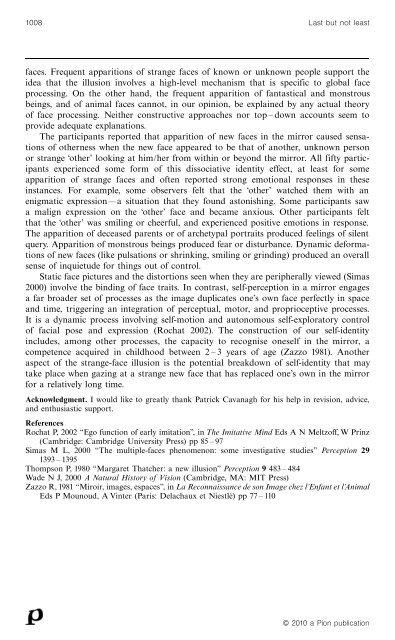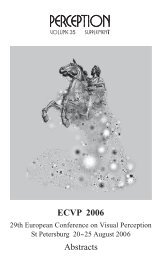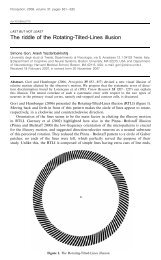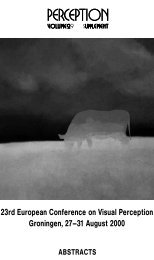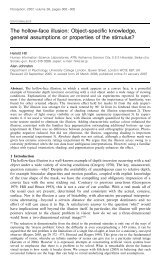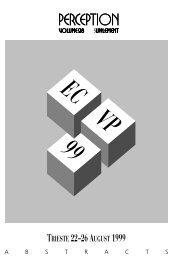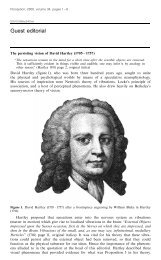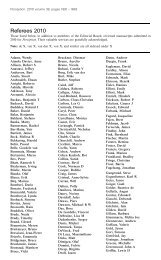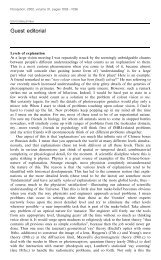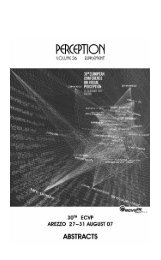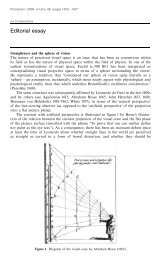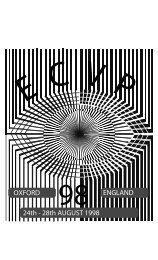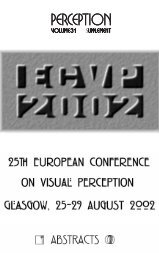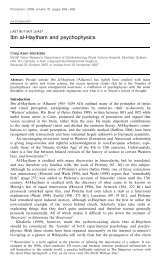Strange-face-in-the-mirror illusion - Perception
Strange-face-in-the-mirror illusion - Perception
Strange-face-in-the-mirror illusion - Perception
Create successful ePaper yourself
Turn your PDF publications into a flip-book with our unique Google optimized e-Paper software.
1008 Last but not least<br />
<strong>face</strong>s. Frequent apparitions of strange <strong>face</strong>s of known or unknown people support <strong>the</strong><br />
idea that <strong>the</strong> <strong>illusion</strong> <strong>in</strong>volves a high-level mechanism that is specific to global <strong>face</strong><br />
process<strong>in</strong>g. On <strong>the</strong> o<strong>the</strong>r hand, <strong>the</strong> frequent apparition of fantastical and monstrous<br />
be<strong>in</strong>gs, and of animal <strong>face</strong>s cannot, <strong>in</strong> our op<strong>in</strong>ion, be expla<strong>in</strong>ed by any actual <strong>the</strong>ory<br />
of <strong>face</strong> process<strong>in</strong>g. Nei<strong>the</strong>r constructive approaches nor top ^ down accounts seem to<br />
provide adequate explanations.<br />
The participants reported that apparition of new <strong>face</strong>s <strong>in</strong> <strong>the</strong> <strong>mirror</strong> caused sensations<br />
of o<strong>the</strong>rness when <strong>the</strong> new <strong>face</strong> appeared to be that of ano<strong>the</strong>r, unknown person<br />
or strange `o<strong>the</strong>r' look<strong>in</strong>g at him/her from with<strong>in</strong> or beyond <strong>the</strong> <strong>mirror</strong>. All fifty participants<br />
experienced some form of this dissociative identity effect, at least for some<br />
apparition of strange <strong>face</strong>s and often reported strong emotional responses <strong>in</strong> <strong>the</strong>se<br />
<strong>in</strong>stances. For example, some observers felt that <strong>the</strong> `o<strong>the</strong>r' watched <strong>the</strong>m with an<br />
enigmatic expressionöa situation that <strong>the</strong>y found astonish<strong>in</strong>g. Some participants saw<br />
a malign expression on <strong>the</strong> `o<strong>the</strong>r' <strong>face</strong> and became anxious. O<strong>the</strong>r participants felt<br />
that <strong>the</strong> `o<strong>the</strong>r' was smil<strong>in</strong>g or cheerful, and experienced positive emotions <strong>in</strong> response.<br />
The apparition of deceased parents or of archetypal portraits produced feel<strong>in</strong>gs of silent<br />
query. Apparition of monstrous be<strong>in</strong>gs produced fear or disturbance. Dynamic deformations<br />
of new <strong>face</strong>s (like pulsations or shr<strong>in</strong>k<strong>in</strong>g, smil<strong>in</strong>g or gr<strong>in</strong>d<strong>in</strong>g) produced an overall<br />
sense of <strong>in</strong>quietude for th<strong>in</strong>gs out of control.<br />
Static <strong>face</strong> pictures and <strong>the</strong> distortions seen when <strong>the</strong>y are peripherally viewed (Simas<br />
2000) <strong>in</strong>volve <strong>the</strong> b<strong>in</strong>d<strong>in</strong>g of <strong>face</strong> traits. In contrast, self-perception <strong>in</strong> a <strong>mirror</strong> engages<br />
a far broader set of processes as <strong>the</strong> image duplicates one's own <strong>face</strong> perfectly <strong>in</strong> space<br />
and time, trigger<strong>in</strong>g an <strong>in</strong>tegration of perceptual, motor, and proprioceptive processes.<br />
It is a dynamic process <strong>in</strong>volv<strong>in</strong>g self-motion and autonomous self-exploratory control<br />
of facial pose and expression (Rochat 2002). The construction of our self-identity<br />
<strong>in</strong>cludes, among o<strong>the</strong>r processes, <strong>the</strong> capacity to recognise oneself <strong>in</strong> <strong>the</strong> <strong>mirror</strong>, a<br />
competence acquired <strong>in</strong> childhood between 2 ^ 3 years of age (Zazzo 1981). Ano<strong>the</strong>r<br />
aspect of <strong>the</strong> strange-<strong>face</strong> <strong>illusion</strong> is <strong>the</strong> potential breakdown of self-identity that may<br />
take place when gaz<strong>in</strong>g at a strange new <strong>face</strong> that has replaced one's own <strong>in</strong> <strong>the</strong> <strong>mirror</strong><br />
for a relatively long time.<br />
Acknowledgment. I would like to greatly thank Patrick Cavanagh for his help <strong>in</strong> revision, advice,<br />
and enthusiastic support.<br />
References<br />
Rochat P, 2002 ``Ego function of early imitation'', <strong>in</strong> The Imitative M<strong>in</strong>d Eds A N Meltzoff, W Pr<strong>in</strong>z<br />
(Cambridge: Cambridge University Press) pp 85 ^ 97<br />
Simas M L, 2000 ``The multiple-<strong>face</strong>s phenomenon: some <strong>in</strong>vestigative studies'' <strong>Perception</strong> 29<br />
1393 ^ 1395<br />
Thompson P, 1980 ``Margaret Thatcher: a new <strong>illusion</strong>'' <strong>Perception</strong> 9 483 ^ 484<br />
Wade N J, 2000 A Natural History of Vision (Cambridge, MA: MIT Press)<br />
Zazzo R, 1981 ``Miroir, images, espaces'', <strong>in</strong> La Reconnaissance de son Image chez l'Enfant et l'Animal<br />
Eds P Mounoud, A V<strong>in</strong>ter (Paris: Delachaux et Niestle¨ )pp77^110<br />
ß 2010 a Pion publication


